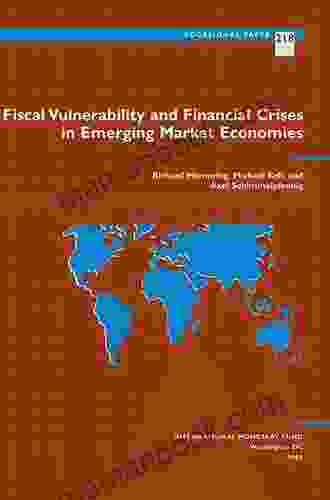Fiscal Vulnerability and Financial Crises in Emerging Market Economies: A Long Tail Perspective

Abstract
Emerging market economies (EMEs) have been experiencing a rise in fiscal vulnerability in recent years, which has made them more susceptible to financial crises. This article examines the relationship between fiscal vulnerability and financial crises in EMEs, and identifies the long tail factors that contribute to this vulnerability. The article argues that long tail factors, such as political instability, corruption, and weak institutions, can create a cycle of fiscal vulnerability and financial instability in EMEs. The article concludes by recommending policy measures to address these long tail factors and reduce the risk of financial crises in EMEs.
Fiscal vulnerability is a major risk factor for financial crises in emerging market economies (EMEs). EMEs are characterized by high levels of public debt, large fiscal deficits, and weak institutions. These factors make EMEs more vulnerable to shocks, such as changes in global interest rates, exchange rates, and commodity prices. When these shocks occur, EMEs can experience a sudden loss of market confidence, which can lead to a financial crisis.
4.6 out of 5
| Language | : | English |
| File size | : | 3142 KB |
| Text-to-Speech | : | Enabled |
| Enhanced typesetting | : | Enabled |
| Word Wise | : | Enabled |
| Print length | : | 124 pages |
| Screen Reader | : | Supported |
The relationship between fiscal vulnerability and financial crises in EMEs has been well-documented in the literature. A number of studies have found that EMEs with high levels of fiscal vulnerability are more likely to experience financial crises. For example, a study by the International Monetary Fund (IMF) found that EMEs with fiscal deficits of more than 5% of GDP are twice as likely to experience a financial crisis as EMEs with fiscal deficits of less than 3% of GDP.
In addition to high levels of fiscal vulnerability, EMEs are also vulnerable to financial crises due to a number of other factors, such as:
- Weak institutions
- Political instability
- Corruption
- Large external debt
- High levels of foreign exchange reserves
These factors can create a cycle of fiscal vulnerability and financial instability in EMEs. For example, weak institutions can lead to fiscal indiscipline and high levels of public debt. Political instability can lead to a loss of market confidence and a sudden withdrawal of capital. Corruption can lead to a misallocation of resources and a decline in public investment. Large external debt can make EMEs vulnerable to changes in global interest rates and exchange rates. High levels of foreign exchange reserves can create a false sense of security and lead to complacency.
The combination of these factors can create a situation in which EMEs are highly vulnerable to financial crises. When a shock occurs, such as a global financial crisis, EMEs can experience a sudden loss of market confidence, which can lead to a financial crisis.
Long Tail Factors
In addition to the traditional risk factors for financial crises in EMEs, there are a number of long tail factors that can also contribute to fiscal vulnerability. Long tail factors are factors that are not typically considered to be major risk factors, but which can have a significant impact over time. These factors include:
- Demographic changes
- Climate change
- Technological change
- Globalization
- Resource scarcity
These factors can create a cycle of fiscal vulnerability and financial instability in EMEs by eroding the fiscal capacity of the government and increasing the demand for public resources. For example, demographic changes, such as population aging, can lead to a decline in the labor force and a decrease in tax revenues. Climate change can lead to natural disasters, which can damage infrastructure and disrupt economic activity. Technological change can lead to job displacement and a decline in wages. Globalization can lead to increased competition and a decline in the bargaining power of workers. Resource scarcity can lead to higher commodity prices and a decline in economic growth.
The combination of these long tail factors can create a situation in which EMEs are increasingly vulnerable to financial crises. When a shock occurs, such as a global financial crisis, EMEs can experience a sudden loss of market confidence, which can lead to a financial crisis.
Policy Recommendations
There are a number of policy measures that EMEs can take to address the risks of fiscal vulnerability and financial crises. These measures include:
- Reducing fiscal deficits
- Increasing public saving
- Strengthening institutions
- Reducing corruption
These measures can help to reduce EMEs' vulnerability to financial crises by building up fiscal buffers and increasing market confidence. EMEs should also consider adopting macroeconomic policies that are designed to promote sustainable growth and stability. These policies include:
- Maintaining low inflation
- Maintaining a stable exchange rate
- Avoiding excessive external debt
- Building up foreign exchange reserves
These policies can help to reduce the likelihood of a sudden loss of market confidence and a financial crisis.
Fiscal vulnerability is a major risk factor for financial crises in emerging market economies. EMEs are characterized by high levels of public debt, large fiscal deficits, and weak institutions. These factors make EMEs more vulnerable to shocks, such as changes in global interest rates, exchange rates, and commodity prices. In addition to these traditional risk factors, EMEs are also vulnerable to financial crises due to a number of long tail factors, such as demographic changes, climate change, technological change, globalization, and resource scarcity. These factors can create a cycle of fiscal vulnerability and financial instability in EMEs. EMEs can reduce their vulnerability to financial crises by adopting policies that reduce fiscal deficits, increase public saving, strengthen institutions, and reduce corruption. EMEs should also consider adopting macroeconomic policies that promote sustainable growth and stability.
4.6 out of 5
| Language | : | English |
| File size | : | 3142 KB |
| Text-to-Speech | : | Enabled |
| Enhanced typesetting | : | Enabled |
| Word Wise | : | Enabled |
| Print length | : | 124 pages |
| Screen Reader | : | Supported |
Do you want to contribute by writing guest posts on this blog?
Please contact us and send us a resume of previous articles that you have written.
 Top Book
Top Book Novel
Novel Fiction
Fiction Nonfiction
Nonfiction Literature
Literature Paperback
Paperback Hardcover
Hardcover E-book
E-book Audiobook
Audiobook Bestseller
Bestseller Classic
Classic Mystery
Mystery Thriller
Thriller Romance
Romance Fantasy
Fantasy Science Fiction
Science Fiction Biography
Biography Memoir
Memoir Autobiography
Autobiography Poetry
Poetry Drama
Drama Historical Fiction
Historical Fiction Self-help
Self-help Young Adult
Young Adult Childrens Books
Childrens Books Graphic Novel
Graphic Novel Anthology
Anthology Series
Series Encyclopedia
Encyclopedia Reference
Reference Guidebook
Guidebook Textbook
Textbook Workbook
Workbook Journal
Journal Diary
Diary Manuscript
Manuscript Folio
Folio Pulp Fiction
Pulp Fiction Short Stories
Short Stories Fairy Tales
Fairy Tales Fables
Fables Mythology
Mythology Philosophy
Philosophy Religion
Religion Spirituality
Spirituality Essays
Essays Critique
Critique Commentary
Commentary Glossary
Glossary Bibliography
Bibliography Index
Index Table of Contents
Table of Contents Preface
Preface Introduction
Introduction Foreword
Foreword Afterword
Afterword Appendices
Appendices Annotations
Annotations Footnotes
Footnotes Epilogue
Epilogue Prologue
Prologue Rachael Thomas M S Ed
Rachael Thomas M S Ed Dr Edward Joseph
Dr Edward Joseph Carter Godwin Woodson
Carter Godwin Woodson Edward Marston
Edward Marston Jenna Austin
Jenna Austin Katrina Cope
Katrina Cope Jonas E Alexis
Jonas E Alexis Margareta Magnusson
Margareta Magnusson Matt Forbeck
Matt Forbeck Zach Sears
Zach Sears John Monyjok Maluth
John Monyjok Maluth Randy Rainbow
Randy Rainbow Ernesto Che Guevara
Ernesto Che Guevara Lian Hearn
Lian Hearn Print Replica Kindle Edition
Print Replica Kindle Edition R D Brady
R D Brady Mika Lane
Mika Lane Benjamin T Smith
Benjamin T Smith Rachel Gibson
Rachel Gibson Tyrone L Waller
Tyrone L Waller
Light bulbAdvertise smarter! Our strategic ad space ensures maximum exposure. Reserve your spot today!

 Francis TurnerUnleash the Power of Imagination: Explore the Art of Creating, Enriching, and...
Francis TurnerUnleash the Power of Imagination: Explore the Art of Creating, Enriching, and... Dean CoxFollow ·4.5k
Dean CoxFollow ·4.5k Tom ClancyFollow ·16.3k
Tom ClancyFollow ·16.3k Garrett PowellFollow ·16.5k
Garrett PowellFollow ·16.5k Enrique BlairFollow ·11.6k
Enrique BlairFollow ·11.6k Ivan TurgenevFollow ·3.5k
Ivan TurgenevFollow ·3.5k Logan CoxFollow ·7.6k
Logan CoxFollow ·7.6k DeShawn PowellFollow ·9.1k
DeShawn PowellFollow ·9.1k Don ColemanFollow ·16.3k
Don ColemanFollow ·16.3k

 Ernest Powell
Ernest PowellBenefits of Corporal Punishment: A Review of the...
Corporal punishment is a form of physical...

 Bobby Howard
Bobby HowardThe Development and Significance of African American...
African American...

 Guy Powell
Guy PowellDown Girl: The Logic of Misogyny - A Comprehensive...
In her groundbreaking work,...

 Forrest Blair
Forrest BlairThe Bikini Changing Room: A Micro Mini Romance
In the heart of...
4.6 out of 5
| Language | : | English |
| File size | : | 3142 KB |
| Text-to-Speech | : | Enabled |
| Enhanced typesetting | : | Enabled |
| Word Wise | : | Enabled |
| Print length | : | 124 pages |
| Screen Reader | : | Supported |














